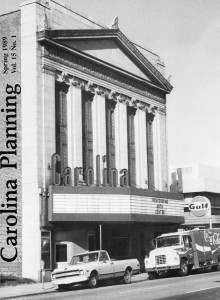 Volume 15.1 Historic Preservation (1989)
Volume 15.1 Historic Preservation (1989)
Devoting an entire issue to the role of preservation in planning may seem unusual. Often, practitioners view advocates of historic and environmental preservation as obstructionists rooted in the values of the past, disrupting the work of those moving a community forward. However, contrary to these lingering perceptions, the goal of preservationists and conservationists is not clinging to the past nor thwarting change. As the following articles demonstrate, a preservation ethic has in fact been adopted by an ever-broadening spectrum of professionals, as well as the general public; and the achievements the authors describe here have been remarkable.
Instead of viewing the cityscape as merely a stage upon which to continually “implement new strategies” or as a canvas to wipe clean, these individuals seek to sensitively manage change. Many authors draw to our attention the ways in which commonly overlooked aspects of our historic, cultural and natural heritage should and can be brought into the planning and development process. Bungalow neighborhoods, urban parks, pavement patterns, street trees, and “community character” may seem far less tangible than antebellum mansions and vast tracts of open land; however, these more subtle elements are equally important in the preservation of the local identity and “sense of place” of a particular area.
If these new approaches challenge the typical view of history and historic preservation, so may the cast of characters. Members of a wide variety of professions are being educated and exposed to preservation; among those contributing to this issue of Carolina Planning are local government representatives, landscape architects, artists, historians, lawyers, and planners. These participants are taking an active stance, forming coalitions and mobilizing political and civic resources. Instead of simply waiting to react to unwelcome proposals, they are anticipating ways to guide growth and suggesting new means with which to enhance the overall quality of life.
Editors: Irving Boykins, Paul M. Kron, Elizabeth Morton, Trina Gauld, and Julia Vant-Hull
A digital version of this issue is available here.
| LAND TRUSTS: FOCUSING LIMITED RESOURCES ON COMMON INTERESTS
Blaha, Kathleen This article discusses the importance of land trusts and other locally-based preservation and conservation organizations to resource protection. Such organizations can and should play a vital role in education and creation of broad-based constituency for land conservation, historic preservation, and sensible land use decisions. |
| A LOCAL GOVERNMENT PERSPECTIVE
Swain, Jeffrey; Sette, Kathryn This article discusses the evolution of Rochester’s strong historic preservation movement along with instructive guidelines for building an effective preservation coalition. |
| THE ARTS AND PRESERVATION: A NATURAL AFFINITY
Salzman, Marjorie The author discusses the evolving connection between planning, preservation, and arts. She described the spectacular results of arts groups combining forces with preservationists in North Carolina and provides insights into these relationships. |
| “PRESERVATION: WHERE HAVE WE BEEN, WHERE ARE WE GOING?
Stipe, Robert Stipe examines changes in historic preservation, looking at the role of the federal government. He advocates more local control and provides a checklist to help communities develop local preservation plans. |
| VERNACULAR ARCHITECTURE AND THE PRESERVATION OF LOCAL CULTURAL IDENTITY
Larson, John Larson describes the forces that have broadened the preservation field and presents a framework for communities to understand and work with resources that strengthen cultural identity. |
| ART, HISTORY, AND PUBLIC SPACE: BUSTER SIMPSON ON STEWARDSHIP
Morton, Elizabeth This reprint of Seattle artist Buster Simpson demonstrates ways in which his artistic sensibilities expand the traditional scope of urban planning and preservation. |
| A NONLINEAR APPROACH TO OPEN SPACE
Flournoy, William The article traces the development of the Raleigh Greenway system. A nonlinear approach evolved due to Raleigh’s existing institutional structure and the greenway’s changing constituency. After considerable struggle, the greenway concept has been embraced in many North Carolina cities and a simpler, more linear approach is in place. |